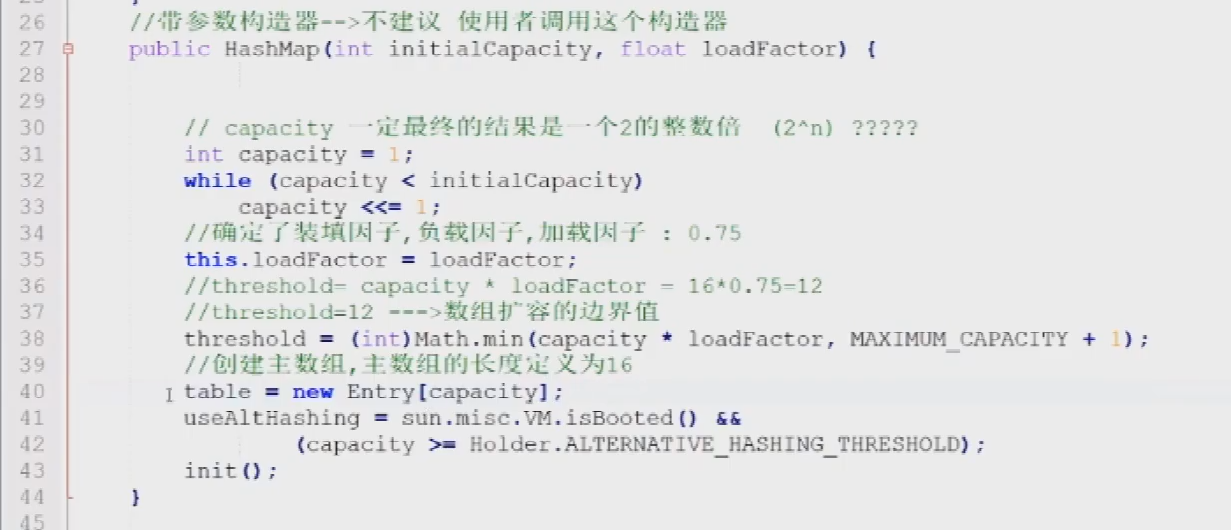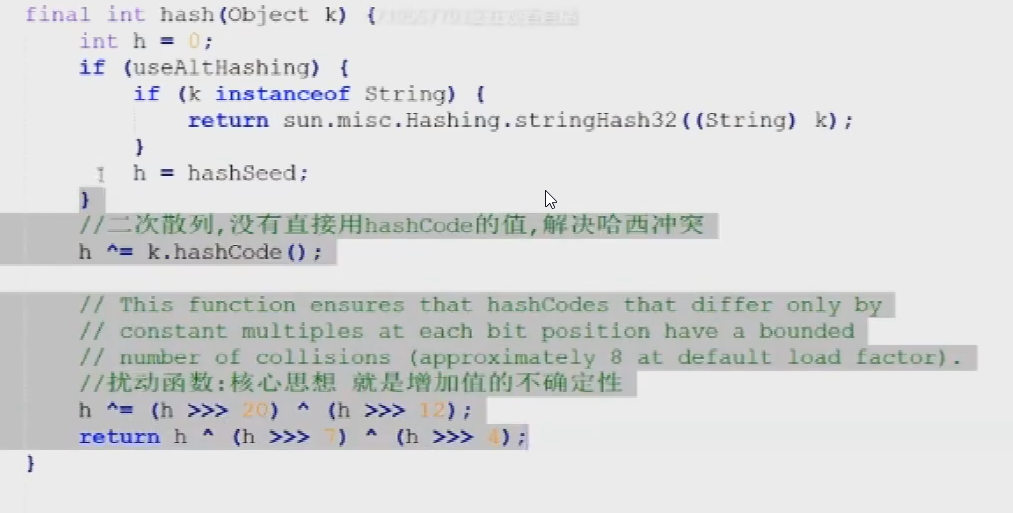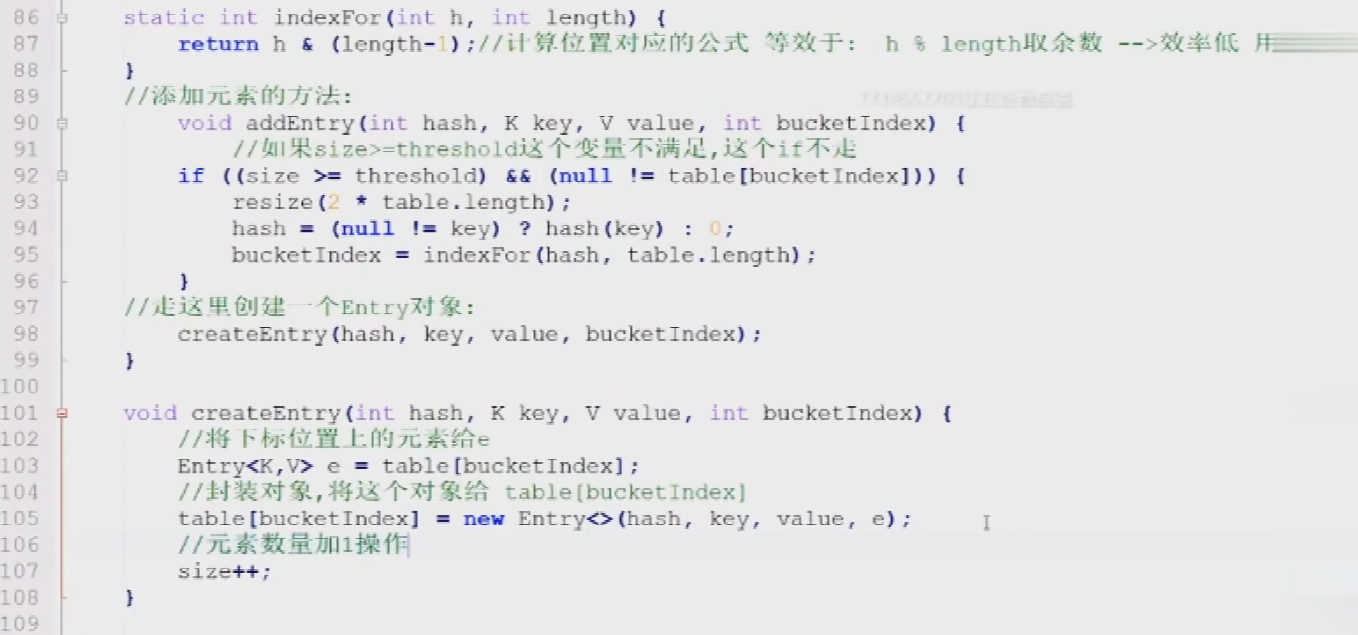1.7的hashMap
学习hashMap具备的基础:位运算,集成,接口的实现,数据结构,数组+链表(红黑树)
https://www.bilibili.com/video/BV1H3411q7s7?p=8
拓展:左移相当于乘以2,右移除以2。
https://www.yuque.com/shier-tcmwp/notes/vb9f90






1.8的hashMap
资料来源:https://www.bilibili.com/video/BV1yX4y1w7ng?share_source=copy_web
public class HashMap<K, V> extends AbstractMap<K, V>implements Map<K, V>, Cloneable, Serializable { // 1、实现了两个Map接口,重复--》多余// 3、属性部分static final float DEFAULT_LOAD_FACTOR = 0.75f;final float loadFactor;// DEFAULT_INITIAL_CAPACITY.)int threshold;transient Node<K,V>[] table; // 底层数组// 2、 调用空构造器public HashMap() {this.loadFactor = DEFAULT_LOAD_FACTOR; // loadFactor = 0.75}// 4、调用有参构造器public HashMap(int initialCapacity) { //10this(initialCapacity, DEFAULT_LOAD_FACTOR); // this(10,0.75)}//5、跳到HashMap中public HashMap(int initialCapacity, float loadFactor) { // 10,0.75// 6、提高健壮性处理if (initialCapacity < 0)throw new IllegalArgumentException("Illegal initial capacity: " +initialCapacity);if (initialCapacity > MAXIMUM_CAPACITY)initialCapacity = MAXIMUM_CAPACITY;if (loadFactor <= 0 || Float.isNaN(loadFactor))throw new IllegalArgumentException("Illegal load factor: " +loadFactor);// 7、loadFactor = 0.75this.loadFactor = loadFactor;// 8、调用tableSizeFor方法,传入10this.threshold = tableSizeFor(initialCapacity);}/*** Returns a power of two size for the given target capacity.* 9、tableSizeFor---》确定主数组的长度 ---》返回的是最接近参数的2的n次幂 ----》10=》16 3=》4 6=》8*/static final int tableSizeFor(int cap) { // 10int n = cap - 1;n |= n >>> 1;n |= n >>> 2;n |= n >>> 4;n |= n >>> 8;n |= n >>> 16;return (n < 0) ? 1 : (n >= MAXIMUM_CAPACITY) ? MAXIMUM_CAPACITY : n + 1;}// 10、调用put方法public V put(K key, V value) {\// 11、调用hash方法return putVal(hash(key), key, value, false, true);}// 12、hash方法,返回值就是hash码static final int hash(Object key) {int h;return (key == null) ? 0 : (h = key.hashCode()) ^ (h >>> 16);}// 13、putVal方法final V putVal(int hash, K key, V value, boolean onlyIfAbsent,boolean evict) {Node<K,V>[] tab; Node<K,V> p; int n, i;if ((tab = table) == null || (n = tab.length) == 0)// 14、调用resize方法,该方法n = (tab = resize()).length;if ((p = tab[i = (n - 1) & hash]) == null)tab[i] = newNode(hash, key, value, null);else {Node<K,V> e; K k;if (p.hash == hash &&((k = p.key) == key || (key != null && key.equals(k))))e = p;else if (p instanceof TreeNode)e = ((TreeNode<K,V>)p).putTreeVal(this, tab, hash, key, value);else {for (int binCount = 0; ; ++binCount) {if ((e = p.next) == null) {p.next = newNode(hash, key, value, null);if (binCount >= TREEIFY_THRESHOLD - 1) // -1 for 1sttreeifyBin(tab, hash);break;}if (e.hash == hash &&((k = e.key) == key || (key != null && key.equals(k))))break;p = e;}}if (e != null) { // existing mapping for keyV oldValue = e.value;if (!onlyIfAbsent || oldValue == null)e.value = value;afterNodeAccess(e);return oldValue;}}++modCount;if (++size > threshold)resize();afterNodeInsertion(evict);return null;}// 15、调用resize方法final Node<K,V>[] resize() {Node<K,V>[] oldTab = table;int oldCap = (oldTab == null) ? 0 : oldTab.length;int oldThr = threshold;int newCap, newThr = 0;if (oldCap > 0) {if (oldCap >= MAXIMUM_CAPACITY) {threshold = Integer.MAX_VALUE;return oldTab;}else if ((newCap = oldCap << 1) < MAXIMUM_CAPACITY &&oldCap >= DEFAULT_INITIAL_CAPACITY)newThr = oldThr << 1; // double threshold}else if (oldThr > 0) // initial capacity was placed in thresholdnewCap = oldThr;else { // zero initial threshold signifies using defaultsnewCap = DEFAULT_INITIAL_CAPACITY;newThr = (int)(DEFAULT_LOAD_FACTOR * DEFAULT_INITIAL_CAPACITY);}if (newThr == 0) {float ft = (float)newCap * loadFactor;newThr = (newCap < MAXIMUM_CAPACITY && ft < (float)MAXIMUM_CAPACITY ?(int)ft : Integer.MAX_VALUE);}threshold = newThr;@SuppressWarnings({"rawtypes","unchecked"})Node<K,V>[] newTab = (Node<K,V>[])new Node[newCap];// 16、resize方法从开始到这里都是确定table的大小。重要的地方是就是这里,table:底层的数组长度在这里确定了,为一个xxx长度的Node类型的数组table = newTab;if (oldTab != null) {for (int j = 0; j < oldCap; ++j) {Node<K,V> e;if ((e = oldTab[j]) != null) {oldTab[j] = null;if (e.next == null)newTab[e.hash & (newCap - 1)] = e;else if (e instanceof TreeNode)((TreeNode<K,V>)e).split(this, newTab, j, oldCap);else { // preserve orderNode<K,V> loHead = null, loTail = null;Node<K,V> hiHead = null, hiTail = null;Node<K,V> next;do {next = e.next;if ((e.hash & oldCap) == 0) {if (loTail == null)loHead = e;elseloTail.next = e;loTail = e;}else {if (hiTail == null)hiHead = e;elsehiTail.next = e;hiTail = e;}} while ((e = next) != null);if (loTail != null) {loTail.next = null;newTab[j] = loHead;}if (hiTail != null) {hiTail.next = null;newTab[j + oldCap] = hiHead;}}}}}return newTab;}}
经典面试题:
1、装填因子,装载因子,加载因子为什么要设置为0.75。
装填因子设置为1,空间利用率得到大大的提高,很容易发生碰撞,产生链表-》查询效率低
装填因子设置为0.5,空间利用率太低了,碰撞几率也低,产生链表低-》查询效率高。
所以取了一个折中的:0.75
2、主数组的长度为什么必须为2的n次方。
原因1:h & (length - 1)等效 h % length 操作,等效的前提是:length必须是2的整数倍。
原因2:防止哈希冲突,位置冲突。
- 验证是整数倍:
length:8
hash :3 00000011
length-1 00000111
——————————————————与运算,相同为1,不同为0
00000011 —-》3 位置
hash :2 00000010
length-1 00000111
——————————————————
00000010 ——-》2位置
- 验证不是整数倍:
length:9
hash :3 00000011
length-1 00001000
—————————————
00000000 ——》0位置
hash :2 00000010
length-1 00001000
—————————————————
00000000 ——》0位置
3、头插法为什么有循环问题

